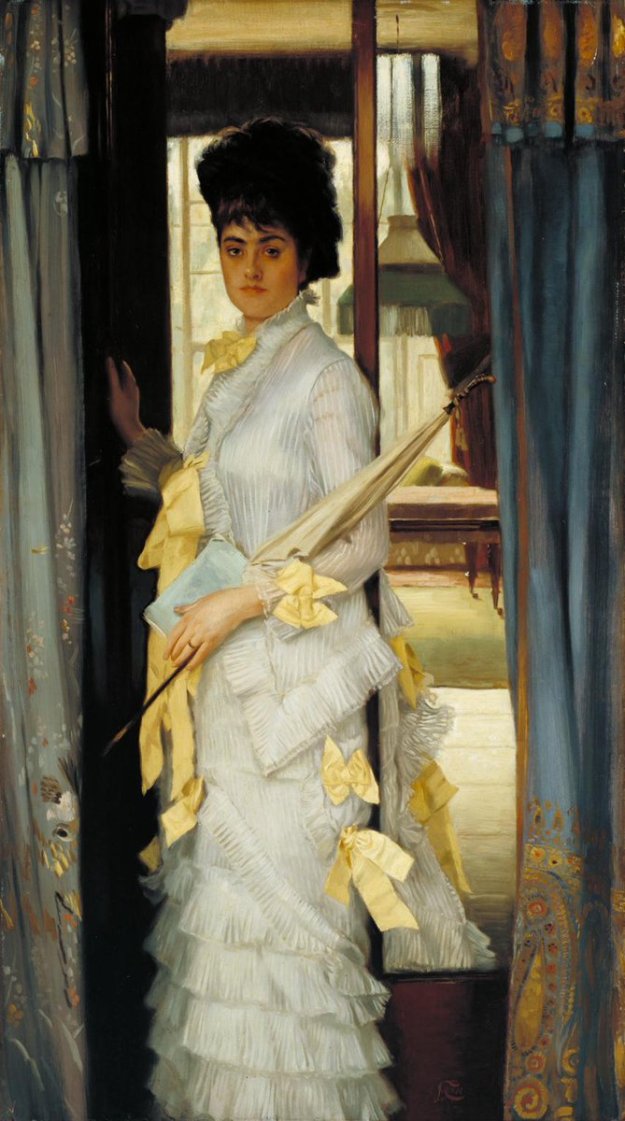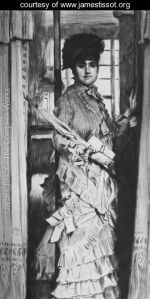To cite this article: Paquette, Lucy. Tissot in the U.K.: London, at the Tate. The Hammock. https://thehammocknovel.wordpress.com/2014/02/20/tissot-in-the-u-k-london-at-the-tate/ . <Date viewed.>
Five of James Tissot’s most famous works are in the collection of the Tate in London: The Ball on Shipboard, Holyday, A Portrait, The Gallery of HMS Calcutta (Portsmouth), and Portsmouth Dockyard.

The Ball on Shipboard (c. 1874), by James Tissot. Oil on canvas, 33 1/8 by 51 in. (84 by 130 cm.). Tate, London. (Photo: Wikimedia.org)
Tissot exhibited The Ball on Shipboard at the Royal Academy in London from May through August 1874, three years after he had left Paris in the aftermath of the Franco-Prussian War. Reviewers (but interestingly, not Tissot himself) identified the setting as the yearly regatta at Cowes, on the Isle of Wight. Tissot assured Berthe Morisot, who was at Cowes during regatta week the following year while on her honeymoon with Édouard Manet’s brother, Eugène, that they saw the most fashionable society in England. But one critic of The Ball on Shipboard wrote, “The girls who are spread about in every attitude are evidently the ‘high life below stairs’ of the port, who have borrowed their mistresses’ dresses for the nonce,” and another objected to the unseemly amount of cleavage revealed by the women wearing the blue and green day dresses (left of center). Another critic found in the picture, “no pretty women, but a set of showy rather than elegant costumes, some few graceful, but more ungraceful attitudes, and not a lady in a score of female figures.” Yet another found it “garish and almost repellent.” Regardless, London art dealer William Agnew (1825 – 1910) – who specialized in “high-class modern paintings” – purchased The Ball on Shipboard from Tissot that year and sold it to Hilton Philipson (1834 – 1904), a solicitor and colliery owner living at Tynemouth. (Philipson also spent 620 guineas at Agnew’s for John Everett Millais’ 1874 painting, The Picture of Health, a portrait of Millais’ daughter, Alice (later Mrs. Charles Stuart Wortley).
The Ball on Shipboard later belonged to Philipson’s son’s widow, Mrs. Roland Philipson (c. 1866 – 1945), then the Leicester Galleries, London, and by 1937, to Alfred Munnings (1878 – 1959), a self-taught equine painter who loathed Modernism and revered artists such as James Tissot, for their pictures that aimed “to fill a man’s soul with admiration and sheer joy, not to bewilder him and daze him.” (Summer in February, a film released in 2013 based on Jonathan Smith’s 1995 novel and starring Dominic Cooper, Dan Stevens and Emily Browning, dramatizes the love triangle between the young Alfred Munnings, his friend, and the woman they both loved.) Munnings was elected a Royal Academician in 1925, and The Ball on Shipboard was presented to the Tate by the Trustees of the Chantrey Bequest in 1937. The painting is not on display.

Holyday (c. 1876), by James Tissot. Oil on canvas, 30 by 39 1/8 in. (76.5 by 99.5 cm.). Tate Britain. (Photo: Wikimedia.org)
Tissot painted members of the famous I Zingari cricket club (which still exists, and is one of the oldest amateur cricket clubs) in their distinctive black, red and gold caps in his garden at 17 Grove End Road, St. John’s Wood, which was only a few hundred yards from Lord’s cricket ground. [Interestingly, Lord’s cricket ground was purchased by Isaac Moses, father of Tissot’s one-time art dealer, Algernon Moses Marsden, in 1858; Isaac sold Lord’s in 1866 to the Marylebone Cricket Club for a handsome profit.] Holyday was owned by James Taylor, who lent it for exhibition at the Grosvenor Gallery in London from May to June, 1877. Oscar Wilde, then a 23-year-old student at Magdalen College, Oxford, reviewed the Grosvenor’s exhibition in Dublin University Magazine that summer, skewering the subject matter of Holyday as “Mr. Tissot’s over-dressed, common-looking people, and ugly, painfully accurate representation of modern soda water bottles.” In 1928, the painting was purchased by the Tate from Thos. McLean Ltd., a London art gallery, with the Clarke Fund. Holyday is on display at Tate Britain in room 1840; click here for an interactive look at it.

A Portrait (1876), by James Tissot. Oil on canvas, 36 by 20 in. (91.5 by 51 cm.). Tate, London. (Photo: Wikimedia.org)
 A Portrait (1876) was exhibited by Tissot at the new Grosvenor Gallery, London, from May to June 1877. It later was owned by John Polson, Thornley and Tranent, whose executors sold it at Christie’s, London, in 1911, as An Afternoon Call.
A Portrait (1876) was exhibited by Tissot at the new Grosvenor Gallery, London, from May to June 1877. It later was owned by John Polson, Thornley and Tranent, whose executors sold it at Christie’s, London, in 1911, as An Afternoon Call.
It was purchased by the Dutch art dealer Elbert Jan van Wisselingh (1848 – 1912), London, for £44.2.0, and the Tate purchased it from Mrs. Isa van Wisselingh (1858-1931) with the Clarke Fund in 1927. Mrs. van Wisselingh, née Isabella Murray Mowat Angus, was the daughter of Scottish art dealer William Craibe Angus (1830-1899).
It often is called Portrait of Miss Lloyd because Tissot made a print after it, and though it was a variation on the painting, the model for the print was identified at an auction in 1903 as Miss Lloyd. The oil portrait is not on display.

The Gallery of the HMS Calcutta (Portsmouth), c. 1876, by James Tissot. Oil on canvas, 27 by 36 1/8 in. (68.5 by 92 cm). Tate, London. (Photo: the-athenaeum.org)
 Tissot exhibited The Gallery of HMS Calcutta (Portsmouth), c. 1876, at the Grosvenor Gallery from May to June 1877. The painting puzzled some critics, who felt its meaning should have been made clear by Tissot. At least one critic admired it, writing, “We would direct our readers’ attention to the painting of the flesh seen through the thin white muslin dresses…manual dexterity could hardly achieve a greater triumph.” The picture was owned by J. Robertson Reid, then Henry Trengrouse, Teddington. It was sold by Trengrouse’s executors at the Puttick and Simpson sale in London in 1929, and purchased by the Leicester Galleries, London, for 16 guineas. It then was purchased by industrialist and art collector Samuel Courtauld (1876 – 1947), London. By 1908, Courtauld was general manager of Samuel Courtauld and Company, Great Britain’s dominant silk producer, which had developed rayon, an artificial silk fiber produced by chemically treating and spinning wood pulp, and was marketing it by 1905. Courtauld served as chairman of the family firm, which had become a £12 million international business, from 1921 to 1946. He founded London’s Courtauld Institute of Art in 1932 and also created a fund for the Tate and the National Gallery to acquire national collections of Impressionist and Post-Impressionist art. Courtauld presented The Gallery of HMS Calcutta to the Tate in 1936, but it is not on display.
Tissot exhibited The Gallery of HMS Calcutta (Portsmouth), c. 1876, at the Grosvenor Gallery from May to June 1877. The painting puzzled some critics, who felt its meaning should have been made clear by Tissot. At least one critic admired it, writing, “We would direct our readers’ attention to the painting of the flesh seen through the thin white muslin dresses…manual dexterity could hardly achieve a greater triumph.” The picture was owned by J. Robertson Reid, then Henry Trengrouse, Teddington. It was sold by Trengrouse’s executors at the Puttick and Simpson sale in London in 1929, and purchased by the Leicester Galleries, London, for 16 guineas. It then was purchased by industrialist and art collector Samuel Courtauld (1876 – 1947), London. By 1908, Courtauld was general manager of Samuel Courtauld and Company, Great Britain’s dominant silk producer, which had developed rayon, an artificial silk fiber produced by chemically treating and spinning wood pulp, and was marketing it by 1905. Courtauld served as chairman of the family firm, which had become a £12 million international business, from 1921 to 1946. He founded London’s Courtauld Institute of Art in 1932 and also created a fund for the Tate and the National Gallery to acquire national collections of Impressionist and Post-Impressionist art. Courtauld presented The Gallery of HMS Calcutta to the Tate in 1936, but it is not on display.

Portsmouth Dockyard (c. 1877) by James Tissot. Oil on canvas, 15 by 21 1/2 in. (38 by 54.5 cm). Tate, London. (Photo: Wikipaintings.org)

The Thames (1876), by James Tissot. Oil on canvas, 28.5 by 46.5 in. (72.5 by 118 cm.). Hepworth Wakefield Art Gallery, Wakefield, UK. Courtesy of The Bridgeman Art Library for use in “The Hammock: A novel based on the true story of French painter James Tissot” by Lucy Paquette © 2012
Exhibited at the Grosvenor Gallery from May to June 1877 as Portsmouth Dockyard, the scene depicts an officer wearing the uniform of the 42nd Royal Highland regiment, known as the “Black Watch.” The picture was well-received, which was Tissot’s intention after the harsh criticism of The Thames the previous year at the Royal Academy exhibition in 1876. Reviewers objected to that painting for what they considered the depiction of a thoroughly unBritish subject – prostitution. The two women in The Thames were perceived as “undeniably Parisian ladies,” and the picture itself, “More French, shall we say, than English?” But the Times art critic described the subsequent version, Portsmouth Dockyard, as a painting in which “a happy Highland sergeant finds himself to his huge content afloat in company with two sprightly ladies.”
Portsmouth Dockyard was owned successively by Henry Jump (1820 – 1893), a wealthy Justice of the Peace and corn merchant living at Gateacre, Lancashire; James Jump, Ipswich, who died at 50 in 1905; and Captain Henry Jump, Heytesbury. Captain Jump sold the picture at Christie’s, London, in 1937 as Divided Attention. It was purchased by Leicester Galleries, London, for 58 guineas, and sold to novelist Sir Hugh Walpole 1884 – 1941), London. Walpole had just been knighted, having returned from Hollywood, where he wrote two screenplays for David O. Selznick: David Copperfield (1935), in which he had a bit part as the Vicar of Blunderstone, and Little Lord Fauntleroy (1936). Walpole also was an art collector who left fourteen works to the Tate and the Fitzwilliam Museum in Cambridge. Portsmouth Dockyard was bequeathed to the Tate by Walpole in 1941 and is not on display.
Related blog posts:
Who was Algernon Moses Marsden?
James Tissot’s house at St. John’s Wood, London
Tissot in the U.K.: London, at The Geffrye & the Guildhall
© 2014 by Lucy Paquette. All rights reserved.
The articles published on this blog are copyrighted by Lucy Paquette. An article or any portion of it may not be reproduced in any medium or transmitted in any form, electronic or mechanical, without the author’s permission. You are welcome to cite or quote from an article provided you give full acknowledgement to the author.

If you do not have a Kindle e-reader, you may download free Kindle reading apps for PCs, Smartphones, tablets, and the Kindle Cloud Reader to read The Hammock: A novel based on the true story of French painter James Tissot. Read reviews.
The Hammock: A novel based on the true story of French painter James Tissot, brings Tissot’s world from 1870 to 1879 alive in a story of war, art, Society glamour, love, scandal, and tragedy.
Illustrated with 17 stunning, high-resolution fine art images in full color
Courtesy of The Bridgeman Art Library
(295 pages; ISBN (ePub): 978-0-615-68267-9). See http://www.amazon.com/dp/B009P5RYVE.